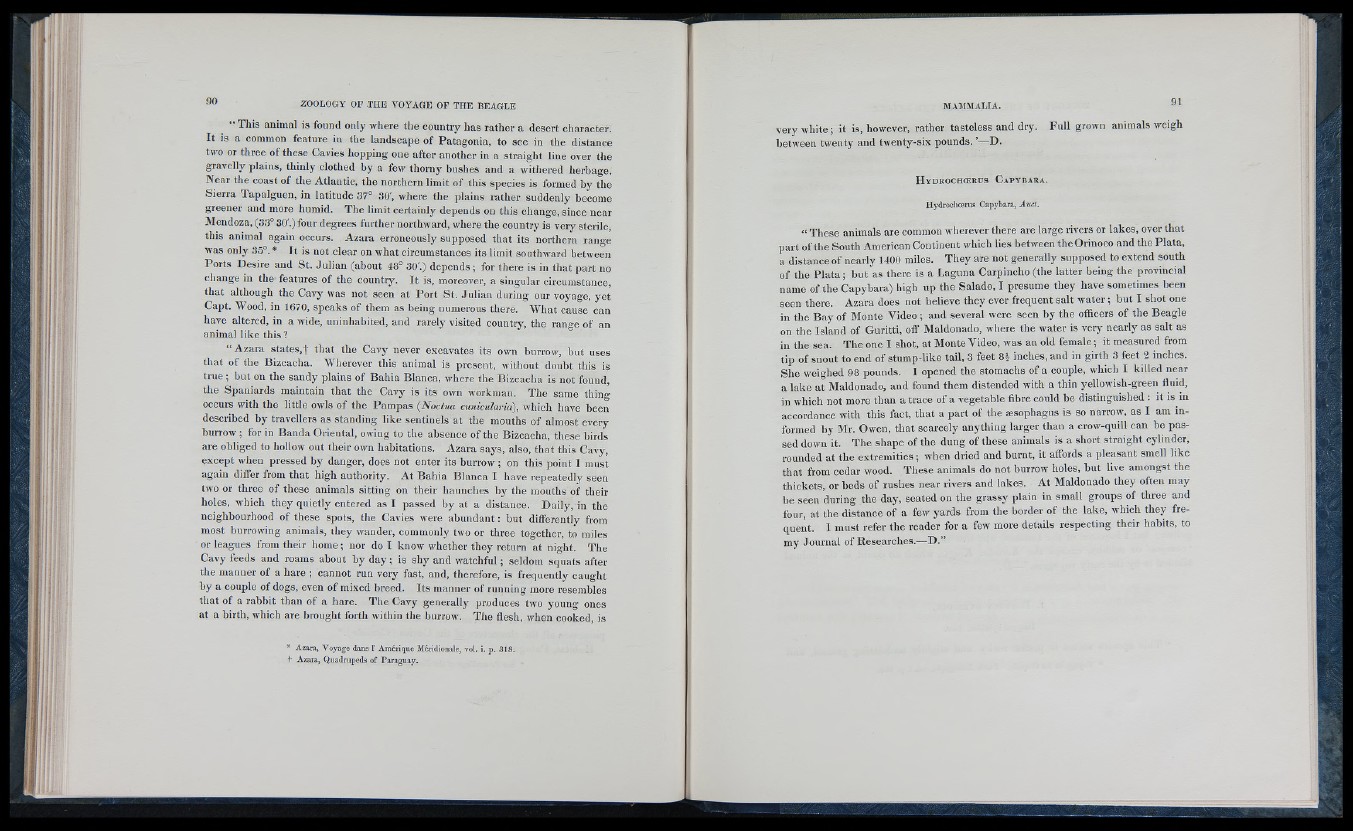
“ This animal is found only where the country lias rather a desert character.
It is a common feature in the landscape of Patagonia, to see in tlie distance
two or three of these Cavies hopping one after another in a straight line over the
gravelly plains, thinly clothed by a few thorny bushes and a withered lierbage.
Near the coast of tlie Atlantic, the northern limit of tliis species is formed by the
Sierra Tapalguen, in latitude 37° 30', where the plains rather suddenly become
greener and more Inimid. The limit certainly depends on this change, since near
Mendoza, (33° 30'.) four degrees further northward, where the coimtry is very sterile,
tills animal again occurs. Azara erroneously supposed that its northern range
was only 35°. * It is not clear on what circumstances its limit southward between
Ports Desire and St. Julian (about 48° .30'.) depends ; for there is in that part no
change in the features of the country. It is, moreover, a singular circumstance,
that although the Cavy was not seen at Port St. Julian during our voyage, yet
Capt. Wood, in 1670, speaks of tliem as being numerous there. Wliat cause can
liave altered, in a wide, uninhabited, and rarely visited coimtry, the range of an
animal like this ?
“ Azara states,! ‘hat the Cavy never excavates its own burrow, but uses
that of tile Bizcacha. Wlieiever tliis animal is present, without doubt this is
true; but on the sandy plains of Bahia Blanca, where the Bizcacha is not found,
the Spaniards maintain that the Cavy is its own workman. The same thing
occurs with the little owls of the Pampas {Noctua cuniciilarid), which have been
described by travellers as standing like sentinels at the mouths of almost every
burrow ; for in Banda Oriental, owing to the absence of the Bizcacha, tliese birds
are obliged to hollow out their own iiabitations, Azara says, also, tliat this Cavy,
except when pressed by danger, does not enter its burrow ; on this point I must
again differ from that high authority. At Bahia Blanca I have repeatedly seen
two or three of these animals sitting on their haunches by the mouths of tlieir
holes, which they quietly entered as I passed by at a distance. Daily, in the
neighbourhood of these spots, the Cavies were abundant: but differently from
most burrowing animals, they wander, commonly two or three together, to miles
or leagues from their home; nor do I know whether they return at night. The
Cavy feeds and roams about by d ay; is shy and watchful; seldom squats after
the manner of a hare ; cannot run very fast, and, therefore, is frequently caught
by a couple of dogs, even of mixed breed. Its manner of running more resembles
tliat of a rabbit than of a hare. Tlie Cavy generally produces two young ones
at a birth, which are brought forth within the burrow. The flesh, when cooked, is
* Azara, Voyage dans 1’ Amérique Méridionale, vol. i. p. 318.
t Azara, Quadrupeds of Paraguay.
very white ; it is, however, rather tasteless and dry.
between twenty and twenty-six pounds. ’—D.
Full grown animals weigh
H y d r o c h (e r u s C a p y b a r a .
Ilydroclioerus Capybara, Auct.
“ These animals are common wherever there are large rivers or lakes, over that
part of the South American Continent which lies between the Orinoco and the Plata,
a distance of nearly 1400 miles. They are not generally supposed to extend south
of the Plata; but as there is a Laguna Carpincho (the latter being the provincial
name of the Capybara) high up the Salado, I presume they have sometimes been
seen there. Azara does not believe they ever frequent salt water; but I shot one
in the Bay of Monte Video ; and several were seen by the officers of the Beagle
on the Island of Guritti, off Maldonado, where the water is very nearly as salt as
in the sea. The one I shot, at Monte Video, was an old female; it measured from
tip of snout to end of stump-like tail. 3 feet 84 inches, and in girth 3 feet 2 inches.
She weighed 98 pounds. I opened the stomachs of a couple, which I killed near
a lake at Maldonado, and found them distended with a thin yellowish-green fluid,
in which not more than a trace of a vegetable fibre could be distinguished : it is in
accordance with this fact, that a part of the msophagus is so narrow, as I am informed
by Mr. Owen, that scarcely anything larger than a crow-quill can be passed
down it. The shape of the dung of these animals is a short straight cylinder,
rounded at the extremities ; when dried and burnt, it affords a pleasant smell like
that from cedar wood. These animals do not burrow holes, but live amongst the
thickets, or beds of rushes near rivers and lakes. At Maldonado they often may
be seen during the day, seated on the grassy plain in small groups of three and
four, at the distance of a few yards from the border of the lake, which they frequent.
I must refer the reader for a few more details respecting their habits, to
my Journal of Researches.—D .”